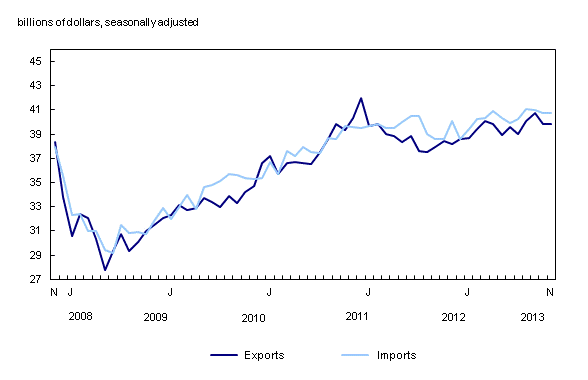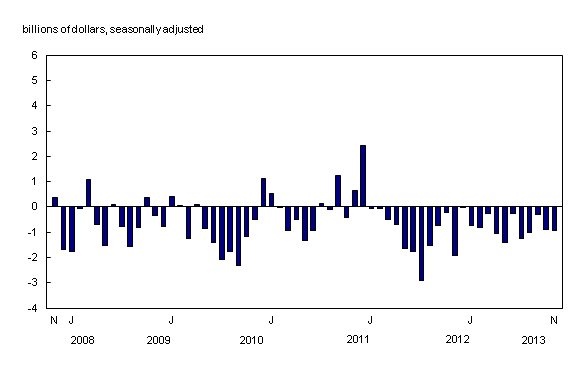Canadian international merchandise trade, November 2013
Archived Content
Information identified as archived is provided for reference, research or recordkeeping purposes. It is not subject to the Government of Canada Web Standards and has not been altered or updated since it was archived. Please "contact us" to request a format other than those available.
Released: 2014-01-07
Canada's merchandise imports edged up 0.1% while exports were unchanged in November. As a result, Canada's trade deficit with the world went from $908 million in October to $940 million in November.
Imports edged up to $40.7 billion, as prices were up 0.1% and volumes remained the same. Increases in imports in most sections were almost offset by large decreases in basic and industrial chemical, plastic and rubber products, as well as in energy products.
Exports were unchanged at $39.8 billion, as prices increased 0.7% while volumes were down 0.7%. Basic and industrial chemical, plastic and rubber products; energy products; industrial machinery, equipment and parts; and consumer goods recorded the largest declines in exports. Motor vehicles and parts had the largest increase.
Imports from the United States grew 2.0% to $27.2 billion, led by higher imports of aircraft. Exports to the United States were up 0.6% to $30.0 billion, with motor vehicles and parts being the main contributor. Consequently, Canada's trade surplus with the United States narrowed from $3.1 billion in October to $2.8 billion in November.
Imports from countries other than the United States fell 3.6% to $13.5 billion. There were widespread declines among the principal trading areas, with the largest occurring for "all other countries" (-4.0%). Exports to countries other than the United States declined 2.0% to $9.8 billion, with the European Union (-6.4%) recording the largest decline. As a result, Canada's trade deficit with countries other than the United States narrowed from $4.0 billion in October to $3.7 billion in November.
Imports edge up
Imports of industrial machinery, equipment and parts rose 8.5% to $3.9 billion in November. Leading the increase were other general-purpose machinery and equipment (+12.4%), and agricultural, lawn and garden machinery and equipment (+28.3%). Overall, volumes were up 7.5%.
Imports of motor vehicles and parts increased 3.4% to $7.4 billion, almost entirely on volumes (+3.3%). Higher imports of passenger cars and light trucks (+5.5%) as well as motor vehicle engines and motor vehicle parts (+4.9%) were the main contributors to the gain.
Imports of aircraft and other transportation equipment and parts grew 17.3% to $1.5 billion. Imports of aircraft increased from $40 million in October to $313 million in November to lead the gains in this section.
Imports of energy products declined 16.3% to $2.9 billion. Imports of crude oil and crude bitumen decreased for a third consecutive month, down 24.9% to $1.5 billion in November on lower volumes and prices.
Imports of basic and industrial chemical, plastic and rubber products fell 16.2% to $3.2 billion. Imports of lubricants and other petroleum refinery products declined $624 million to $353 million in November, after rising by $478 million in October. Overall, volumes fell 19.8%.
Exports flat as price increases offset declines in volumes
Exports of basic and industrial chemical, plastic and rubber products fell 7.0% to $2.8 billion in November, on lower volumes. Lubricants and other petroleum refinery products, as well as basic chemicals were the main contributors to the section's decrease in exports.
Exports of energy products declined 1.6% to $9.3 billion. Crude oil and crude bitumen fell 2.0% to $6.7 billion, a third consecutive decrease after reaching a record high in August 2013. Overall, volumes declined 1.2% and prices were down 0.5%.
Exports of industrial machinery, equipment and parts decreased 4.7% to $2.2 billion, entirely on volumes. The main contributor to this section's decline in exports was other general-purpose machinery and equipment (-11.7%), mainly boilers, tanks and heavy gauge metal containers.
Exports of consumer goods declined 2.2% to $4.4 billion. Pharmaceutical and medicinal products fell $113 million to $559 million in November, after rising by $141 million in October.
Exports of motor vehicles and parts rose 9.6% to $6.0 billion. The increase was led by motor vehicle engines and motor vehicle parts (+23.5%) and passenger cars and light trucks (+6.6%). Overall, volumes were up 8.5%.
Note to readers
Merchandise trade is one component of Canada's international balance of payments (BOP), which also includes trade in services, investment income, current transfers as well as capital and financial flows.
International merchandise trade data by country are available on both a BOP and a customs basis for the United States, Japan and the United Kingdom. Trade data for all other individual countries are available on a customs basis only. BOP data are derived from customs data by making adjustments for factors such as valuation, coverage, timing and residency. These adjustments are made to conform to the concepts and definitions of the Canadian System of National Accounts.
Data in this release are on a BOP basis, seasonally adjusted and in current dollars. Constant dollars are calculated using the Laspeyres volume formula (2007=100).
For more information on seasonal adjustment, see Seasonal adjustment and identifying economic trends.
Revisions
In general, merchandise trade data are revised on an ongoing basis for each month of the current year. Current year revisions are reflected in both the customs and BOP based data.
The previous year's customs data are revised with the release of the January and February reference months as well as on a quarterly basis. The previous two years of customs based data are revised annually and are released in February with the December reference month.
The previous year's BOP based data are revised with the release of the January, February and March reference months. Revisions to BOP based data for the previous four years were released in June with the April reference month.
Factors influencing revisions include late receipt of import and export documentation, incorrect information on customs forms, replacement of estimates produced for the energy section with actual figures, changes in classification of merchandise based on more current information, and changes to seasonal adjustment factors.
Revised data are available in the appropriate CANSIM tables.
These data are now available in the Canadian International Merchandise Trade Database (Catalogue number65F0013X). From the Browse by key resource module of our website, choose Publications.
The November 2013 issue of Canadian International Merchandise Trade, Vol. 67, no. 11 (Catalogue number65-001-X), is also now available from the Browse by key resource module of our website under Publications.
Data on Canadian international merchandise trade for December will be released on February 6.
Contact information
For more information, contact us (toll-free 1-800-263-1136; 514-283-8300; infostats@statcan.gc.ca).
To enquire about the concepts, methods or data quality of this release, contact Alec Forbes (613-951-0325), International Trade Division.
- Date modified:



